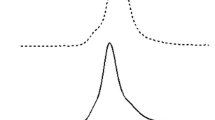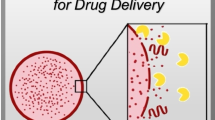Abstract
Purpose. The aim of the present study was to develop a new type of core-shell nanoparticles from a family of novel amphiphilic copolymers, based on dextran (DEX) grafted with poly(ε–caprolactone) (PCL) side chains (PCL-DEX).
Methods. A family of PCL-DEX copolymers was synthesized in which both the molecular weight and the proportion by weight of DEX in the copolymer were varied. The nanoparticles were prepared by a technique derived from emulsion-solvent evaporation, during which emulsion stability was investigated using a Turbiscan. The nanoparticle size distribution, density, zeta potential, morphology, and suitability for freeze-drying were determined.
Results. Because of their strongly amphiphilic properties, the PCL-DEX copolymers were able to stabilize o/w emulsions without the need of additional surfactants. Nanoparticles with a controlled mean diameter ranging from 100 to 250 nm were successfully prepared. A mechanism of formation of these nanoparticles was proposed. Zeta potential measurements confirmed the presence of a DEX coating.
Conclusion. A new generation of polysaccharide-decorated nanoparticles has been successfully prepared from a family of PCL-DEX amphiphilic copolymers. They may have potential applications in drug encapsulation and targeting.
Similar content being viewed by others
REFERENCES
R. Gref, Y. Minamitake, M. T. Peracchia, V. Trubetskoy, V. Torchilin, and R. Langer. Biodegradable long-circulating polymeric nanospheres. Science 263:1600-1603 (1994).
D. Bazile, C. Prud'homme, M. T. Bassoullet, M. Marlard, G. Spenlehauer, and M. Veillard. Stealth MePEG-PLA nanoparticles avoid uptake by the mononuclear phagocytes system. J. Pharm. Sci. 84:493-498 (1995).
M. T. Peracchia, C. Vauthier, D. Desmaele, A. Gulik, J. C. Dedieu, M. Demoy, J. d'Angelo, and P. Couvreur. Pegylated nanoparticles from a novel methoxypolyethylene glycol cyanoacrylate-hexadecyl cyanoacrylate amphiphilic copolymer. Pharm. Res. 15:550-556 (1998).
B. Stella, S. Arpicco, M. T. Peracchia, D. Desmaele, J. Hoebeke, M. Renoir, J. D'Angelo, L. Cattel, and P. Couvreur. Design of folic acid-conjugated nanoparticles for drug targeting. J. Pharm. Sci. 89:1452-1464 (2000).
E. Österberg, K. Bergstrom, K. Holmberg, T. P. Schuman, J. A. Riggs, N. L. Burns, J. M. Van Alstine, and J. M. Harris. Protein-rejecting ability of surface-bound dextran in end-on and side-on configurations: comparison to PEG. J. Biomed. Mater. Res. 29:741-747 (1995).
C. Rouzes, R. Gref, M. Leonard, A. De Sousa Delgado, and E. Dellacherie. Surface modification of poly(lactic acid) nanospheres using hydrophobically modified dextrans as stabilizers in an o/w emulsion/evaporation technique. J. Biomed. Mater. Res. 50:557-565 (2000).
Y. Ohya, S. Maruhashi, and T. Ouchi. Preparation of poly(lactic acid)-grafted amylose through the trimethylsilyl protection method and its biodegradation. Macromol. Chem. Phys. 199:2017-2022 (1998).
Y. Li, C. Volland, and T. Kissel. Biodegradable brush-like graft polymers from poly(D,L-lactide) or poly(D,L-lactide-coglycolide) and charge-modified, hydrophilic dextrans as backbone-in vitro degradation and controlled releases of hydrophilic macromolecules. Polymer 39:3087-3097 (1998).
G. Schwach, J. Coudane, R. Engel, and M. Vert. More about the polymerization of lactides in the presence of stannous octoate. J. Polym. Sci. Pol. Chem. 35:3431-3440 (1997).
R. Gref, J. Rodrigues, and P. Couvreur. Polysaccharides grafted with polyesters: novel amphiphilic copolymers for biomedical applications. Macromolecules 35:9861-9867 (2002).
J. Brandrup, E.H. Immergut, E.A. Grulke, A. Abe, and D.R. Bloch. Polymer Handbook. J. Wiley and sons, New York, 1999.
C. G. Pitt. Poly-ɛ-caprolactone and its copolymers. In M. Chasin and R. Langer (eds.), Biodegradable polymers as drug delivery systems. Marcel Dekker, New York, 1990, pp. 71-120.
P. D. Scholes, A. G. Coombes, L. Illum, S. S. Davis, J. F. Watts, C. Ustariz, M. Vert, and M. C. Davies. Detection and determination of surface levels of poloxamer and PVA surfactant on biodegradable nanospheres using SSIMS and XPS. J. Control. Release 59:261-278 (1999).
J. Briant. PhÉnomÈnes d'interface: Agents de Surface. Editions Technip, Paris, 1989.
P. Quellec, R. Gref, L. Perrin, E. Dellacherie, F. Sommer, J. M. Verbavatz, and M. J. Alonso. Protein encapsulation within polyethylene glycol-coated nanospheres. I. Physicochemical characterization. J. Biomed. Mater. Res. 42:45-54 (1998).
O. Mengual, G. Meunier, I. Cayre, K. Puech, and P. Snabre. Characterisation of instability of concentrated dispersions by a new optical analyser: the TURBISCAN MA 1000. Colloids Surf. A. Physicochem. Eng. Aspects 152:111-123 (1999).
R. Bodmeier and J. W. McGinity. Solvent selection in the preparation of poly(DL-lactide) microspheres prepared by the solvent evaporation method. Int. J. Pharm. 43:179-186 (1988).
D. H. Napper. Steric stabilization. J. Colloid Interface Sci. 58:390-407 (1977).
Author information
Authors and Affiliations
Corresponding author
Rights and permissions
About this article
Cite this article
Lemarchand, C., Couvreur, P., Besnard, M. et al. Novel Polyester-Polysaccharide Nanoparticles. Pharm Res 20, 1284–1292 (2003). https://doi.org/10.1023/A:1025017502379
Issue Date:
DOI: https://doi.org/10.1023/A:1025017502379




